Just when I start to alter my diet to include less red meat and more fish I stumble upon this article...Check out the USAToday link to the original article for some interesting statistics!
By Julie Schmit, Calum MacLeod, Elizabeth Weise and Barbara Hansen, USA TODAY
CHANGLE, China — At the Meihua Aquatic Processing Factory here, hundreds of workers in white coats and masks chop up squid headed for the U.S. market.
The tiled walls and stainless-steel equipment are those of a modern factory. But Meihua also represents the tarnished food-safety reputation that China is trying to shed and the risks facing U.S. consumers who increasingly are eating fish from China, the world's top seafood producer.
U.S. ACTS: Imports of Chinese-raised fish limited
CHINA REACTS: Officials say blocking imports is unfair
In the past 13 months, at least two dozen shipments of catfish, eel and tilapia from Meihua were rejected for entry into the USA by the Food and Drug Administration, FDA records show. The products were rejected because of actual or suspected contamination that included an anti-fungal that battles fish diseases but isn't allowed by the FDA because it has been shown to increase cancer rates in lab animals.
Recently, there have been massive recalls linked to tainted ingredients in pet food, toothpaste and toy trains that came from China, but U.S. consumers are also likely to encounter Chinese seafood.
China has a mixed record on seafood safety.
It exported more than 1 billion pounds of seafood to the USA last year — more than any other nation, says researcher Urner Barry. About 18% of U.S. seafood imports come from China, the National Fisheries Institute says. China also had more seafood imports rejected by the FDA than any other country: 253, almost one-third of which were eel.
Thursday, the FDA placed broad restrictions on imports of Chinese shrimp, catfish, eel, basa (a type of catfish) and dace (similar to carp). The move came after 25% of the Chinese products the FDA sampled from October through May were found to contain residue of chemicals the FDA doesn't allow in fish. Most are known or suspected carcinogens.
China has long had more problems with such contaminants than other countries that send seafood to the USA, says William More, director of the U.S.-based Aquaculture Certification Council, which checks the quality of products for commercial seafood buyers. Last year, More visited 60 shrimp plants in 17 countries, including China.
The ACC inspects, audits and certifies shrimp plants around the world to help buyers — including retailing giant Wal-Mart and Darden Restaurants, owner of Red Lobster — decide from whom to buy, More says.
Such information is critical. Wegmans, an East Coast-based grocery chain, buys only one seafood product from China: frozen, farm-raised tilapia. The grocer has considered other seafood products from China, says spokeswoman Jeanne Colleluori. But after finding it difficult to trace Chinese seafood back to where it was grown, monitor how it was tested and audit processors, "Our decisions have been to go with other producers from other countries," she says.
Chinese officials and fish producers say the country has vastly curtailed the use of anti-fungals banned in U.S. exports in recent years, a contention shared by Rohana Subasinghe, an aquaculture official for the Food and Agriculture Organization (FAO) of the United Nations.
"The use is reducing in China and everywhere," he says.
According to preliminary European Union data the FAO analyzed, the EU rejected 117 seafood shipments from China in 2005, down from 225 three years earlier.
In May, the Chinese government banned the Meihua plant from exporting eel or catfish to the USA until it can prove to Chinese officials that its products are clear of disallowed chemicals.
"We are losing money, about $1 million a month," says Meihua boss Zhang Yinhai, 42, a former soldier who once ran a soft-drink firm for the People's Liberation Army.
He says the company's tests have not detected chemical residue and that the state-owned company's 23 fish farmers don't use them. But he says they may have used them previously and that such chemicals still may be in the mud of farm pools.
"Our company's most basic principle is not to harm the consumer," Zhang says. Meihua is still exporting other seafood to the USA, including squid and tilapia.
Use of anti-fungals targeted
With Chinese seafood, the FDA's main focus is on fish farms' use of chemicals or drugs the agency bans in fish for human consumption. That's because residue can pass from the fish to consumers.
The substances the FDA looks for most often include the anti-fungals malachite green and gentian violet, and the antibiotics chloramphenicol and nitrofurans, a family of microbial agents. They are good at wiping out a range of fish ailments and are used on humans for everything from eye to urinary tract infections. They also are known or suspected carcinogens.
The FDA began testing for the residues in 2001, triggered by concerns of chloramphenicol in shrimp. Although dozens of countries export seafood to the USA, the FDA devotes half of the aquaculture drug tests it does on imported seafood to products from China, says Don Kraemer, deputy director of the FDA's Office of Food Safety.
Kraemer says the antibiotics don't pose an "imminent hazard to health" because they're being detected in "very low" levels. On Thursday, the FDA put ranges for the antibiotics at 1 to 30 parts per billion in the tested seafood.
Another class of antibiotics, fluoroquinolones including ciprofloxacin, also are not allowed in fish for humans. The human risk isn't toxicity, but there are fears that broad use will spur bacterial resistance and make the drugs less effective at treating human infections.
Malachite green, the anti-fungal, is another matter. The chemical dye battles fish parasites and fungal infections. Lab tests have showed increased cancer rates in rats and mice fed malachite green and leucomalachite green, which is formed from malachite green, at doses ranging from 100 to 600 parts per million for two years.
Last year, the FDA restricted imports of eel from China after FDA tests found that 91% of those sampled contained leucomalachite green — some at levels up to 3,239 parts per billion. "That level was disturbingly high," says Kraemer.
China banned malachite green in 2002. Yet the violations indicate that it's still widely used in China's aquaculture industry, the FDA says.
Even before Thursday's move by the FDA, the agency had restricted all eel from China unless the importer proves that it's safe. Last year, Canada also started testing every eel shipment from China for malachite green. Japan and South Korea have restricted Chinese eel imports in recent years as well.
High-risk import
Seafood has long been considered a high-risk import because it's perishable, has a high potential for bacterial contamination and is susceptible to ocean pollutants. Of the imported shipments the FDA refused entry into the USA last year, 58% were cited for filth and salmonella.
But farmed fish, which now account for half the fish U.S. consumers eat, pose new challenges because antibiotics or anti-fungals may be needed to keep them well, especially in developing countries where water pollution is rampant.
Some Chinese farmers continue to use the antibiotics because they are cheap and effective, says Carlos Sanchez, import buyer for Beaver Street Fisheries of Jacksonville, Fla., a leading frozen seafood importer.
China's fish farmers are largely small, family-run operations that sell fish or shrimp to large production facilities, which export the products. The antibiotics work against many diseases, and farmers typically don't need to know exactly what's going wrong in ponds to correct problems, Sanchez says. Beaver Street hires third-party auditors to inspect foreign suppliers.
The Netherlands-based Rabobank International, in a 2005 study, chronicled the pressures facing Chinese fish farmers. The report noted China's "serious" water pollution issues caused primarily by industrial and urban sewage, inadequate quality-control systems, the continued "illegal use of chemicals" to combat fish disease and poor regulatory enforcement so that farmers "have little means or incentive to maintain high quality standards."
Educating Chinese farmers has been a concern for years among nations that receive fish from China. European Union inspectors in 2005 found a new generation of chloramphenicol being used on a fish farm even though the farm had told the inspectors that no antibiotics were present. The EU report says the Chinese official overseeing the farm had approved the powder but didn't know it was an antibiotic.
Chemical and feed salespeople in China take advantage of fish farmers, More says. "They sell these products by telling the farmers fish will grow better. The farmers are simple people, have little education and are easily manipulated."
More says the drug and chemical residues now being found in shipments likely have been in seafood imports for decades.
The enticement to use effective but unsafe antibiotics is obvious to Chinese eel farmers Xie Shandi, 42, and Chai Yuandi, 52. They say the malachite green restrictions have cost them greatly.
Smoking cigarettes and drinking tea under an umbrella in a recent torrential downpour, the farmers say four in 10 eels die before they get to market. When they used malachite green before 2003, they say, just one in 10 died.
The farmers raise the eel in concrete-bottom pools 20 meters long and 10 meters wide at the company in south China's Fujian province.
The eel business used to be easy, Xie says. "I would agree on a price with the buyer, and that was that."
The eels are so packed, they thrash over and under each other. "Fish get sick easily, even by a change in the weather, just like people. So we need to use aquatic medicines," Chai says. "They hardly ever got ill before."
One U.S. importer, Fortuna Sea Products of Rosemead, Calif., gets 80% of its Chinese seafood from Meihua. President John Chiang says he's worked with Meihua to better educate farmers.
Meihua also recently implemented more testing, including sample-testing every load of live fish that goes to the plant and sample-testing finished product, too, he says.
Fortuna also imported 782 cases of clam meat from Meihua that had to be recalled in 2005 for salmonella. Chiang says that product probably wasn't cooked well enough. The FDA, which has no enforcement power over Meihua other than to reject its products, did cite Fortuna. In a 2005 warning letter, the FDA noted "serious deviations" in Fortuna's seafood-safety controls, including lack of effective oversight of its foreign processor.
"I believe they (Meihua) cannot afford a mistake again, and neither can we," Chiang says.
More farmer training
Chinese officials have stopped plants other than Meihua from exporting fish until the government inspects their facilities, says Kevin Wang, secretary-general of the China Catfish Institute, which is linked to the Chinese government. "The main part of the Chinese catfish industry is good," he says.
The government is also doing more farmer training, says Joy Li, general manager Chengdu Fangcao Pharmaceutical in China. The government hired her to run training programs on aquatic medicines, and 300 have been done this year.
Companies have likewise made big investments. Meihua, which exported about $20 million in seafood to the USA last year, expects to spend $400,000 by the end of 2007 on testing equipment so it can better detect drug residue. The Yongyan Aquatic Food Group in Mingguang already has testing equipment in place, bought from U.S. firms Agilent Technologies and BioTek Instruments. "We can meet any U.S. standard," says Wei Shouzhu, vice general manager.
Yet the FDA and others say China still struggles with enforcement — given its thousands of seafood processors and millions of farms.
One of China's primary checks is government tests of seafood exports for chemical residue. If a shipment is clean, it gets a certificate attesting to that, says the FDA's Kraemer. But the FDA has found that some exporters falsify certification documents.
"The Chinese system does not yet have the right supervision and controls to export to the extent it is," says Philippa Kelly, a consultant working in Beijing on food safety issues with the Chinese government.
A primary problem, she says, is lack of resources and will among local government officials, who often are more concerned with revenue, jobs and local development issues than China's overall reputation as a safe source of food.
Kelly also says China needs to concentrate more on education and rely less on punishment and enforcement. "China has good laws and good regulation, but why can't it enforce them? That's a political issue, and that's what makes it so difficult," she says.
Reporting by Calum MacLeod in Beijing, Julie Schmit and Elizabeth Weise in San Francisco and Barbara Hansen in McLean, Va.
Source: http://www.usatoday.com/money/industries/food/2007-06-28-fish-cover-usat_N.htm
Friday, June 29, 2007
Morton's Deal

www.mortons.com/
The Steak and Seafood for Two special at Morton's is back for $99 per couple. This time it's bigger than ever, being available at ALL Morton's locations from now through September 30, 2007. This offer includes: 2 Single Cut FiletsChoice of Two:
Colossal Shrimp Alexander
Jumbo Lump Crab Cake
Broiled Sea ScallopsChoice of Two:
Ceasar Salad
Morton's SaladOne Signature Potato to ShareOne Fresh Vegetable to ShareChoice of Two:
Morton's Legendary Hot Chocolate Cake
Key Lime Pie
Wednesday, June 27, 2007
Restaurant Week in Baltimore
Baltimore Restaurant Week June 30 - August 5 Enjoy $20.07 Lunches and $30.07 Dinners at top local restaurants. Restaurant Week is a great way to experience a 3-course, gourmet meal at terrific savings.Tables fill up quickly, so reserve now!
http://www.opentable.com/promo.aspx?m=18&ref=2477&pid=200
http://www.opentable.com/promo.aspx?m=18&ref=2477&pid=200
Monday, June 25, 2007
Vancouver Day 2
Sorry it's taken so long to update, I've been busy with school and of course...lazy! So on day two, we decided to venture outside of Downtown Vancouver and took the 98B Bus to Richmond. I heard that there are tons of chinese stores/restaurants/plazas here along with the best chinese food in the West. Without a doubt it was! We started our day at Fisherman's Terrace Reaurant in Aberdeen Mall, for midweek, the place was pretty crowded. Here's another link with info on Fisherman's Terrace http://chowtimes.com/2007/01/fishermans_terrace_restaurant.html (I need to learn how to take better pics!)
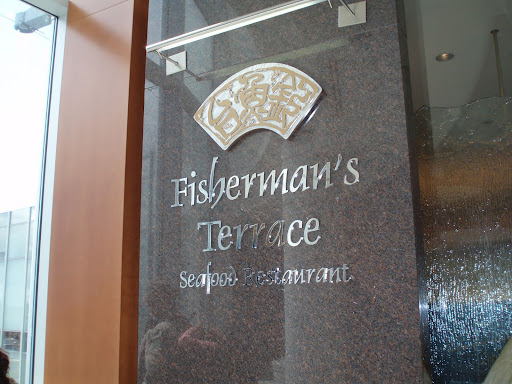
The food was excellent but I was disappointed that they didnt push the dim sum carts around. Instead we got a menu and piece of paper to put down our order. And for first timers, of course we over ordered! I thought 'dim sum' plates were supposed to be small but the portions here were huge, even the shrimp dumplings were really big.

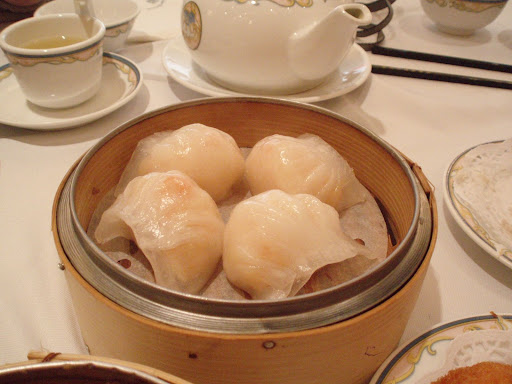
The dumplings really were the size of that tea cup!
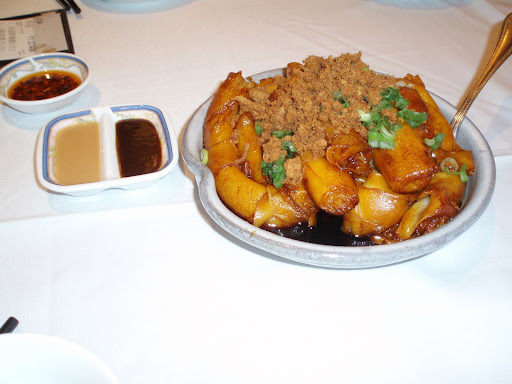
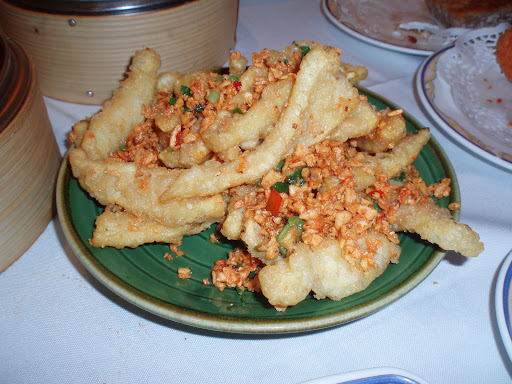
We also had fried calamari with fried garlic on top, too bad they don't serve this at the dim sum places in VA!
So after shopping around at Aberdeen and checking out Daiso (Japan's $2 Store) we headed to President's plaza, another Chinese mall. I wasn't anything good here except a big grocery store that looked like another Grand Mart so I was pretty disappointed. Then we headed to Yaohan, they have really big grocery store here with lots of prepared food, I don't think you need to know how to cook if you live in Richmond or Vancouver. I was too full to really eat anything but I couldn't pass up on the good food so I had to bring some back to the hotel and lemme tell u, it was YUMMIE! Especially those fried dumplings and chicken stuffed with sticky rice!




After we got back to the hotel...of course I had to figure out where I wanted to go for dinner :) After talking to some locals we decided to give Stone Grill a try. At Stone Grill, your meal is served on a very hot molten rock (I think it was about 400 degress) and you basically cook as you eat. We were told that this is a very healthy way of eating since no oils were used and the food is only marinated in some sea salt. The meat was tender and tasted great! I like this place more than Mortons but I dont think my pictures do the meal justice!
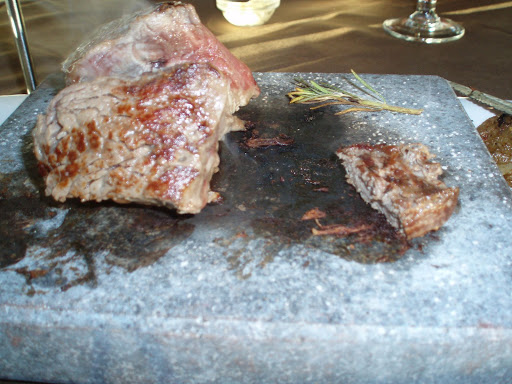

Here are some more pictures of Downtown Vancouver's Chinatown. The food there is really fresh and it reminded me of those markets I see in those Chinese movies.

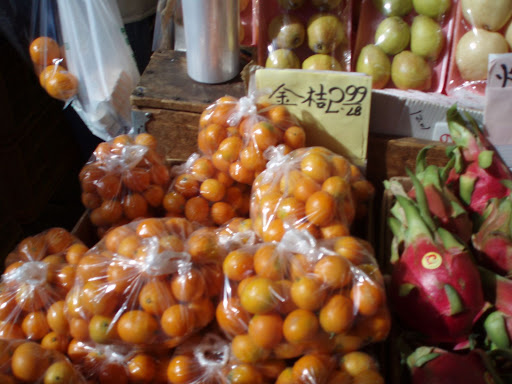

The food was excellent but I was disappointed that they didnt push the dim sum carts around. Instead we got a menu and piece of paper to put down our order. And for first timers, of course we over ordered! I thought 'dim sum' plates were supposed to be small but the portions here were huge, even the shrimp dumplings were really big.


The dumplings really were the size of that tea cup!

Ahh I can't remember what this dish was called but it was really good! It was basically banh cuon (rolled up rice cake?) rolled up and pan fried with a soy sauce like sauce and topped with thit cha bong (dried pork?)!

We also had fried calamari with fried garlic on top, too bad they don't serve this at the dim sum places in VA!
So after shopping around at Aberdeen and checking out Daiso (Japan's $2 Store) we headed to President's plaza, another Chinese mall. I wasn't anything good here except a big grocery store that looked like another Grand Mart so I was pretty disappointed. Then we headed to Yaohan, they have really big grocery store here with lots of prepared food, I don't think you need to know how to cook if you live in Richmond or Vancouver. I was too full to really eat anything but I couldn't pass up on the good food so I had to bring some back to the hotel and lemme tell u, it was YUMMIE! Especially those fried dumplings and chicken stuffed with sticky rice!




After we got back to the hotel...of course I had to figure out where I wanted to go for dinner :) After talking to some locals we decided to give Stone Grill a try. At Stone Grill, your meal is served on a very hot molten rock (I think it was about 400 degress) and you basically cook as you eat. We were told that this is a very healthy way of eating since no oils were used and the food is only marinated in some sea salt. The meat was tender and tasted great! I like this place more than Mortons but I dont think my pictures do the meal justice!


Here are some more pictures of Downtown Vancouver's Chinatown. The food there is really fresh and it reminded me of those markets I see in those Chinese movies.


Subscribe to:
Posts (Atom)